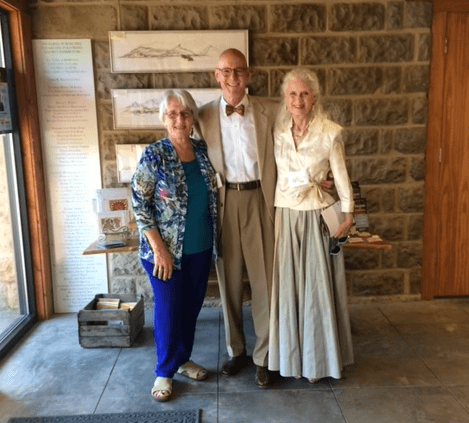The Barns Story and a Chamber Award
by Diana Kincannon
I recently received an honor of which I’m very proud: The 2023 Citizen of the Year Award from the Top of Virginia Chamber of Commerce. The award was in recognition of my years of work for the Barns of Rose Hill, a project to salvage two very old barns in Berryville’s town center and restore them for public service as a center for the arts, education, and community, and to establish an official visitor center.
Many people in Clarke and Frederick counties and the City of Winchester must wonder why the Chamber extended such recognition to me, especially since the Barns opened in 2011 — 13 years ago! It’s because of Jim Wilkins and Donna Downing, and their knowledge of the Barns story, as well as letters of support from a number people who participated in the project with me from 2005 through 2019, excepting 2012 and 2013.
Because it’s a story of determination and of people working together to achieve a desired goal, it may be of interest not only in our area but also in other communities, and I want to share some of it.
My part started in late 2004, when the project was designated a 501(c)3 by the IRS and I was asked to lead the project. We were starting from scratch.
The initial steps were clear: recruit a board of directors, select an architect, design a capital campaign. We knew, too, that strong communication was essential, as were suiting the person to the task, keeping the vision always in mind, raising the visibility and value of the project to constituents as much as we could, and working unstintingly through every challenge that presented itself.
When I say “we”, I mean the board of directors. Although the composition changed over time, the directors worked with high good spirits and strong engagement together.
We spent time developing a mission statement. We identified private and public sources of funding and set about grant-writing and calling on private citizens, foundations, and state and federal representatives. We kept the project in the public’s eye through stories in the Clarke Courier and the
Winchester Star. We offered programs in the arts — we were a “reality without a roof” — with films, costume and fashion shows, pottery shows and sales, music performances. We mailed out thousands of letters. We met regularly with Carter+Burton, our architect and educator in all matters of construction.
We wanted a year-round, multi-use facility that salvaged as much of the original construction as possible, met ADA requirements and had an elevator. We considered energy options such as geothermal and green construction designs.
The funding began to come. Several major donors lent their support. Our third attempt for a VDOT “ICETEA” grant was successful because of the inclusion of a visitor center. Our fourth attempt for a HUD Community Development grant came through with our congressman’s support. A Virginia grant through the Department of Historic Resources had the support of our state delegate. We were persistent in pursuing these.
We learned that federal and state grants required a huge amount of administrative work. We learned that Environmental Impact and Landscape Engineering studies were required, and we took care of it.
The capital campaign started in 2005 and lasted more than six years. Gifts ranged from $5 to $100,000. We raised more than $2 million in public and private funding and in 2010 published an Invitation for Bids. H&W Construction won the day and started work, and we opened to the public in 2011. The facility was beautiful.
I returned then to the job I had before starting the Barns project, and new leadership came in to take the organization into its work as an operating enterprise.
There was a learning curve that kept the Barns from flourishing in its first two years, despite an active events schedule. I had retired in 2013, and I asked the board if I could help. In 2014, I was named chair again, and we established operating committees — in effect, business departments — to see to the organization’s management since we couldn’t afford an executive director. We developed a strong budgeting format and created operating policies and procedures. We focused again on fundraising.
Over the next six years, we stabilized our financial position. We certified the visitor center with the Virginia Tourism Corporation, which required signage on Route 7 and 340, working with VDOT and cost-sharing with the town and county. We became a community partner of the Virginia Museum of Fine Arts, bringing the museum’s Artmobile to Berryville and working with Clarke County schools to bring kids in to see it. Our programs were drawing larger audiences. Our staff of two managed valiantly.
When we could afford a third staff member, we hired Sarah Ames as our office manager, and two years later promoted her to the position of executive director. She brought superb organizational skills that allowed us at last to transition from an operating board to a governing board, an important transition.
Significantly, we were able to establish two $1 million endowments, which finally brought a sense of financial security and enabled us to pay our dedicated and talented staff what they deserved. In 2019, the Barns drew more than 9,000 people to music concerts, art exhibits, workshops, and many other activities. I stepped off the board at the end of 2019, having served the maximum six consecutive years. Post-pandemic, the Barns is again bringing thousands of people through the doors annually. I hope this bit of history is of some value to other communities with ambitious aspirations. As the 19th-century German poet Johann Wolfgang von Goethe said, “Whatever you can do, or dream you can, begin it. Boldness has power and magic in it.”










